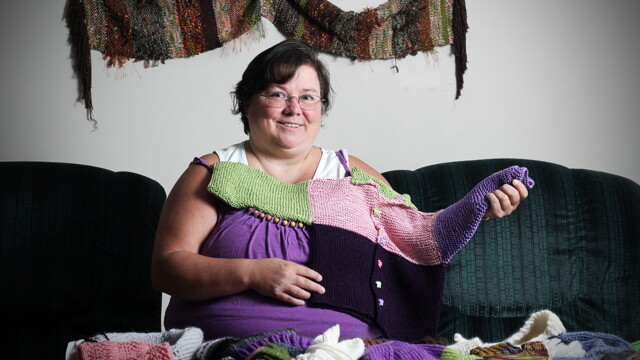In the Mirror
writer explores experience with identity disorder
Marni Kaldjian, photos by Andrea Paulseth |

personality that make up her reality.
Nora Nita Bates is grateful for the opportunity to employ a new medium for her unique voice: her debut memoir, Looking in the Mirror Out. Released on June 1 and self-published through AuthorHouse, this autobiographical work details Fall Creek native Bates’ intense and very personal struggle with mental illness. In a quasi stream-of-consciousness style of writing, Bates allows herself to be vulnerable and open up. “It seems I feel life so deeply to my core,” reads a line from the book, which explains her heightened emotional state and, simultaneously, the level of investment the reader must summon.
“We’re afraid to, but we need to look at our pain to work through it. It’s a self discovery and you have to do the work.”– Nora Nita Bates, author of Looking In The Mirror Out
Yet Bates, 48, refuses to allow the permanent label of “mental illness” to restrict her. In fact, she doesn’t even consider her Dissociative Identity Disorder – Not Otherwise Specified (DID-NOS) an illness. “It’s been a positive adaptation to a messed up world,” says Bates, “What’s difficult is that I can’t always deal with all the energy inside of me.” DID-NOS is different from DID (formerly mislabeled as Multiple Personality Disorder), in that one does not lose consciousness or memory when referring to different personalities. Though apprehensive before our interview (due to my own misconceptions and inexperience with DID-NOS) my fears were quickly assuaged by Bates’ sincere and endearing demeanor.
Trustingly, Bates tells me about her “parts” – the many sections of her brain and personality that make up her reality. There are 18 parts in all. The most prominent three are “Maverick,” whose task is to keep Bates alive, “Rant,” the tenacious, tumultuous part and “Kat,” who feels emotions and sadness the most. Bates writes, “Most [parts] know information others don’t know; they all have their own experiences and perceptions, and sometimes misperceptions.” The book, full of ponderings and self-critical contemplations, tracks Bates’ life with these sometimes loving and other times overwhelming and debilitating “parts” over a span of about 18 months. Through the help of her parts, she recounts her ups and downs through periods of clarity and of naiveté, and how she attempts to move forward.
For 20 years, Bates’ symptoms have existed. She self-diagnosed herself about ten years ago, and has purposely engaged in self-therapy due to disenchantment with the current mental health care system. “What’s out there is so behavior oriented, but there’s a whole thing with the spirit and soul that is lacking in the treatment,” says Bates, “We’re afraid to, but we need to look at our pain to work through it. It’s self discovery and you have to do the work. You want peace in your life? Start creating, co-creating something living and positive.”
Bates’ self therapy includes knitting, meditation, yoga, reading, and writing. “I started journaling just to make sense of all the chaos that is going on in my head,” says Bates. Later, as the words came more easily, her parts started to say to her “We’d like to educate people.” Thus, the book. A large part of Bates’ target audience is for those in the field of psychiatry, but she says the book is for everyone. “Everybody has someone in their life who’s struggling with mental illness... I want the average family member, friend, neighbor, or coworker to get an understanding or [feel] empathy.” The book is dynamic, and discussion seems to be an ongoing part of Bates’ self therapy. In the same way, it may be an opportunity for others to engage in and explore the issues it raises.
She’d like to write another book, perhaps start a blog, and most of all, start a business. According to Bates, the business would urge people to “go into their heads, look at their belief systems, help them figure out how to release the belief system that doesn’t work, and put in something new... I’ll teach people how to knit, how to meditate, and... instead of telling them what to do, I’ll work with them.” Overall, Looking in the Mirror Out compassionately reminds people that they come from love. Says Bates, “We have the power to make choices to make this a beautiful place. We have to take that power back, and that power is love.” Bates’ story ends with the beginning of a New Year, full of hope. The last paragraph reads “I have looked within and am excited to not only look out but to be out… to live my spirit free. Looking in the mirror, out. I want to see others live their spirits free... It’s the year 2012, and I am so excited to be a part of it.”




















